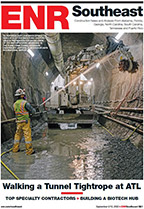A multidisciplinary team of U.S. earthquake researchers and design engineers, organized by the Earthquake Engineering Research Institute (EERI), is leaving Feb. 28 to spend six days in Haiti.
The team, under the leadership of Reginald DesRoches, Professor and Associate Chair of the School of Civil & Environmental Engineering at Georgia Institute of Technology, will document scientific, engineering and societal effects of Jan. 12’s magnitude-7 earthquake.
The goal is to focus on the disaster’s impacts on people, the performance of structures and lifelines, and the enormous societal challenges of relief, recovery and rebuilding, says the Oakland, Calif.-based EERI. Team members plan to meet with local Haitian engineers, architects, and planners, as well as Haitian government officials and business leaders who will lead the nation’s reconstruction.
Estimates suggest more than 212,000 people died, 250,000 were critically injured and over one million Haitians were made homeless by the quake, which was centered some 12 kilometers west of from Port-au-Prince.
Findings from an earlier reconnaissance trip, organized by EERI and the U.S. Geological Society, are available on the EERI website at http://www.eqclearinghouse.org/20100112-haiti/reports-from-the-field/usgseeri-team-report-now-available.
The team, which includes experts in engineering, urban planning, architecture, geography, and community resilience ,will be joined by representatives from partnering organizations. All groups are traveling under DesRoches’ leadership. He is a native of Haiti and a current EERI board member.
A list of team members is available at http://www.eqclearinghouse.org/20100112-haiti/wp-content/uploads/2010/01/Team-Members.pdf. The team will also be collaborating in the field with the American Society of Civil Engineers Technical Council on Lifelines Earthquake Engineering team: http://content.asce.org/TCLEE/Haiti2010.html
For over 30 years, EERI has managed a National Science Foundation-sponsored project called Learning from Earthquakes. The group’s mission is to reduce society’s risk to the effects of earthquakes. EERI says that though earthquakes are unavoidable, disasters such as the one in Haiti are preventable through identified methods of planning, building and preparedness
EERI’s Haiti Virtual Clearinghouse at http://www.eqclearinghouse.org/20100112-haiti/ has more information, including photos and field reports from other investigators who have traveled to Haiti.
The team, under the leadership of Reginald DesRoches, Professor and Associate Chair of the School of Civil & Environmental Engineering at Georgia Institute of Technology, will document scientific, engineering and societal effects of Jan. 12’s magnitude-7 earthquake.
The goal is to focus on the disaster’s impacts on people, the performance of structures and lifelines, and the enormous societal challenges of relief, recovery and rebuilding, says the Oakland, Calif.-based EERI. Team members plan to meet with local Haitian engineers, architects, and planners, as well as Haitian government officials and business leaders who will lead the nation’s reconstruction.
Estimates suggest more than 212,000 people died, 250,000 were critically injured and over one million Haitians were made homeless by the quake, which was centered some 12 kilometers west of from Port-au-Prince.
Findings from an earlier reconnaissance trip, organized by EERI and the U.S. Geological Society, are available on the EERI website at http://www.eqclearinghouse.org/20100112-haiti/reports-from-the-field/usgseeri-team-report-now-available.
The team, which includes experts in engineering, urban planning, architecture, geography, and community resilience ,will be joined by representatives from partnering organizations. All groups are traveling under DesRoches’ leadership. He is a native of Haiti and a current EERI board member.
A list of team members is available at http://www.eqclearinghouse.org/20100112-haiti/wp-content/uploads/2010/01/Team-Members.pdf. The team will also be collaborating in the field with the American Society of Civil Engineers Technical Council on Lifelines Earthquake Engineering team: http://content.asce.org/TCLEE/Haiti2010.html
For over 30 years, EERI has managed a National Science Foundation-sponsored project called Learning from Earthquakes. The group’s mission is to reduce society’s risk to the effects of earthquakes. EERI says that though earthquakes are unavoidable, disasters such as the one in Haiti are preventable through identified methods of planning, building and preparedness
EERI’s Haiti Virtual Clearinghouse at http://www.eqclearinghouse.org/20100112-haiti/ has more information, including photos and field reports from other investigators who have traveled to Haiti.



Post a comment to this article
Report Abusive Comment